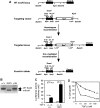SnoN functions as a tumour suppressor by inducing premature senescence
- PMID: 19745809
- PMCID: PMC2782089
- DOI: 10.1038/emboj.2009.250
SnoN functions as a tumour suppressor by inducing premature senescence
Abstract
SnoN represses TGF-beta signalling to promote cell proliferation and has been defined as a proto-oncogene partly due to its elevated expression in many human cancer cells. Although the anti-tumourigenic activity of SnoN has been suggested, the molecular basis for this has not been defined. We showed here that high levels of SnoN exert anti-oncogenic activity by inducing senescence. SnoN interacts with the promyelocytic leukaemia (PML) protein and is recruited to the PML nuclear bodies where it stabilizes p53, leading to premature senescence. Furthermore, overexpression of SnoN inhibits oncogenic transformation induced by Ras and Myc in vitro and significantly blocks papilloma development in vivo in a carcinogen-induced skin tumourigenesis model. The few papillomas that were developed displayed high levels of senescence and spontaneously regressed. Our study has revealed a novel Smad-independent pathway of SnoN function that mediates its anti-oncogenic activity.
Conflict of interest statement
The authors declare that they have no conflict of interest.
Figures








Comment in
-
Oncogene and tumour suppressor: the two faces of SnoN.EMBO J. 2009 Nov 18;28(22):3459-60. doi: 10.1038/emboj.2009.311. EMBO J. 2009. PMID: 19920850 Free PMC article.
Similar articles
-
Expression profiles of SnoN in normal and cancerous human tissues support its tumor suppressor role in human cancer.PLoS One. 2013;8(2):e55794. doi: 10.1371/journal.pone.0055794. Epub 2013 Feb 13. PLoS One. 2013. PMID: 23418461 Free PMC article.
-
Oncogene and tumour suppressor: the two faces of SnoN.EMBO J. 2009 Nov 18;28(22):3459-60. doi: 10.1038/emboj.2009.311. EMBO J. 2009. PMID: 19920850 Free PMC article.
-
SnoN in mammalian development, function and diseases.Curr Opin Pharmacol. 2010 Dec;10(6):670-5. doi: 10.1016/j.coph.2010.08.006. Epub 2010 Sep 6. Curr Opin Pharmacol. 2010. PMID: 20822955 Free PMC article. Review.
-
The transforming activity of Ski and SnoN is dependent on their ability to repress the activity of Smad proteins.J Biol Chem. 2003 Aug 15;278(33):30540-7. doi: 10.1074/jbc.M304016200. Epub 2003 May 22. J Biol Chem. 2003. PMID: 12764135
-
SnoN signaling in proliferating cells and postmitotic neurons.FEBS Lett. 2012 Jul 4;586(14):1977-83. doi: 10.1016/j.febslet.2012.02.048. Epub 2012 Mar 8. FEBS Lett. 2012. PMID: 22710173 Free PMC article. Review.
Cited by
-
Suppression of p53 activity through the cooperative action of Ski and histone deacetylase SIRT1.J Biol Chem. 2011 Feb 25;286(8):6311-20. doi: 10.1074/jbc.M110.177683. Epub 2010 Dec 13. J Biol Chem. 2011. PMID: 21149449 Free PMC article.
-
The tumor suppressor activity of the transmembrane protein with epidermal growth factor and two follistatin motifs 2 (TMEFF2) correlates with its ability to modulate sarcosine levels.J Biol Chem. 2011 May 6;286(18):16091-100. doi: 10.1074/jbc.M110.193805. Epub 2011 Mar 10. J Biol Chem. 2011. PMID: 21393249 Free PMC article.
-
Transcriptional cofactors Ski and SnoN are major regulators of the TGF-β/Smad signaling pathway in health and disease.Signal Transduct Target Ther. 2018 Jun 8;3:15. doi: 10.1038/s41392-018-0015-8. eCollection 2018. Signal Transduct Target Ther. 2018. PMID: 29892481 Free PMC article.
-
Expression profiles of SnoN in normal and cancerous human tissues support its tumor suppressor role in human cancer.PLoS One. 2013;8(2):e55794. doi: 10.1371/journal.pone.0055794. Epub 2013 Feb 13. PLoS One. 2013. PMID: 23418461 Free PMC article.
-
SnoN Antagonizes the Hippo Kinase Complex to Promote TAZ Signaling during Breast Carcinogenesis.Dev Cell. 2016 Jun 6;37(5):399-412. doi: 10.1016/j.devcel.2016.05.002. Epub 2016 May 26. Dev Cell. 2016. PMID: 27237790 Free PMC article.
References
-
- Bartkova J, Rezaei N, Liontos M, Karakaidos P, Kletsas D, Issaeva N, Vassiliou LV, Kolettas E, Niforou K, Zoumpourlis VC, Takaoka M, Nakagawa H, Tort F, Fugger K, Johansson F, Sehested M, Andersen CL, Dyrskjot L, Orntoft T, Lukas J et al. (2006) Oncogene-induced senescence is part of the tumorigenesis barrier imposed by DNA damage checkpoints. Nature 444: 633–637 - PubMed
-
- Bernardi R, Pandolfi PP (2007) Structure, dynamics and functions of promyelocytic leukaemia nuclear bodies. Nat Rev Mol Cell Biol 8: 1006–1016 - PubMed
-
- Blasco MA, Lee HW, Hande MP, Samper E, Lansdorp PM, DePinho RA, Greider CW (1997) Telomere shortening and tumor formation by mouse cells lacking telomerase RNA. Cell 91: 25–34 - PubMed
-
- Bode AM, Dong Z (2004) Post-translational modification of p53 in tumorigenesis. Nat Rev Cancer 4: 793–805 - PubMed
Publication types
MeSH terms
Substances
Grants and funding
LinkOut - more resources
Full Text Sources
Molecular Biology Databases
Research Materials
Miscellaneous

